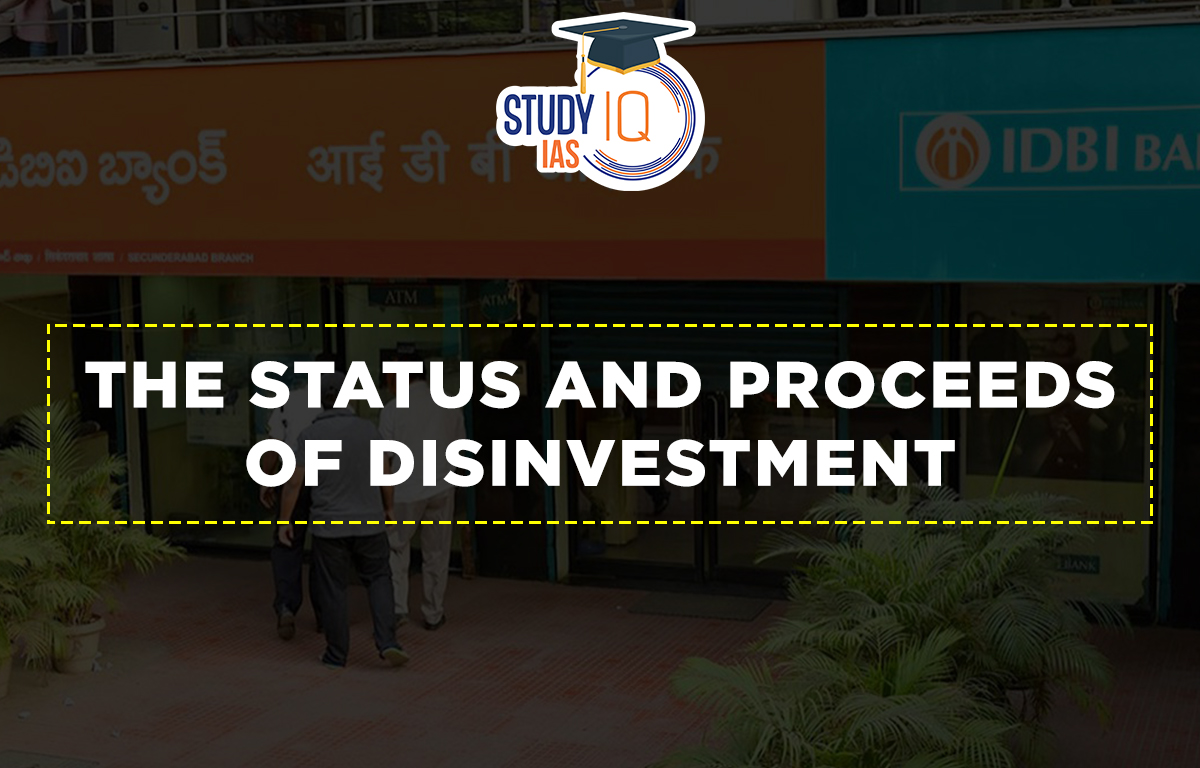Table of Contents
Context: The government has set a disinvestment target at ₹51,000 crore for FY 2023-24, lower than the previous financial year, according to the Union Budget for 2023-24.
Disinvestment Policy for FY 2023-24 as per the Union Budget
- Target: The Centre aims to raise Rs 51,000 crore through the disinvestment of its stake in several state-run firms in the financial year 2023-24 (FY24).
- This is 21 per cent lower than what it expected to earn in the current fiscal year. It is also the lowest target in seven years.
- Companies scheduled for disinvestment: For the FY 2023-24, companies like Shipping Corporation of India, NMDC Steel Ltd, BEML, HLL Lifecare, Container Corporation of India and Vizag Steel, besides IDBI Bank, are in the government’s list for privatization.
About Disinvestment
- Disinvestment or divestment is when the government sells its assets or a subsidiary, such as a Central or State public sector enterprise.
- Types of disinvestment: Minority disinvestment, majority disinvestment, and complete privatization are the three main approaches to disinvestment.
- Minority disinvestment: In this, the government retains a majority in the company, typically greater than 51%, thus ensuring management control.
- Majority divestment: In this, the government hands over control to the acquiring entity but retains some stake.
- Complete privatization: In this, 100% control of the company is passed on to the buyer.
- Implementing agency: The Union Finance Ministry has a separate department for undertaking disinvestment-related procedures called the Department of Investment and Public Asset Management (DIPAM).
- Arguments for and against disinvestment:
| Arguments For | Arguments Against |
| Fiscal Reduction: Disinvestment helps the government reduce its fiscal deficit by reducing its stake in loss-making PSUs and using the proceeds for debt reduction and other developmental initiatives.
Improved Efficiency: Disinvestment can lead to improved efficiency in PSUs as private sector ownership can bring in new management techniques, technology, and capital. Increased Competition: Disinvestment can increase competition in various industries as private players enter and improve the market structure. Resource Mobilization: Disinvestment can be a significant source of resource mobilization for the government as it can generate significant proceeds from the sale of its stakes in PSUs. |
Job Losses: Disinvestment can result in job losses as private owners may reduce the workforce to increase efficiency and profitability.
Negative Impact on Vulnerable Sectors: Disinvestment in certain PSUs providing essential services such as healthcare, education, and electricity can have a negative impact on the vulnerable sections of society. Strategic Assets: Some PSUs may be considered as strategic assets, and their disinvestment can result in a strategic disadvantage for the country. Short-Term Focus: No long-term vision: Disinvestment can be motivated by short-term considerations such as debt reduction and may not consider the long-term benefits of maintaining government ownership. |
How has Disinvestment fared in recent years?
- Failed targets: Different central governments over the last three decades have been able to meet annual disinvestment targets only six times.
- Since 2010, barring two years (2017-18 and 2018-19), the central government’s actual receipts from disinvestment have consistently fallen short of the budget estimate.
- Strategic Disinvestment: The government has shifted its focus from minority stake sales to strategic disinvestments in recent years, with the aim of maximizing returns and improving the efficiency of PSUs.
- Reasons for the failure of targets:
- Lack of investor interest: In some cases, the government has been unable to attract sufficient investor interest, resulting in low demand and low proceeds from disinvestment initiatives.
- Complex procedures: The disinvestment process can be complex and time-consuming, requiring the government to navigate various regulations, legal requirements, and approvals, which can delay or derail initiatives.
- Political opposition: Disinvestment initiatives have often faced opposition from political parties, trade unions, and employee organizations, who are concerned about job losses and the impact on the strategic importance of certain PSUs.
- Market conditions: The performance of the stock market and the economy can greatly impact the success of disinvestment initiatives, as the government may not be able to get the desired price for its stake in PSUs during market downturns.

The Status and Proceeds of Disinvestment in FY 2022-23
- Proceeds from disinvestment: Data from the DIPAM website shows that proceeds from disinvestment stood at Rs 31,106.64 crore, only 48% of the budgeted amount of Rs 65,000 crore.
- FY 2022-23 is the fourth year in a row that the government has missed the budgeted disinvestment target.
- Major share by LIC: Of the ₹31,106 crore generated from disinvestment, a significant portion of close to a third of the budgeted estimate, or ₹20,516 crore, was obtained from the IPO of 3.5% of the Life Insurance Corporation (LIC)’s shares.


 Daily Quiz 17 April 2025
Daily Quiz 17 April 2025
 Nilgiri Biosphere Reserve, Map, Climate,...
Nilgiri Biosphere Reserve, Map, Climate,...
 Complete List of Indian State Animals
Complete List of Indian State Animals





















